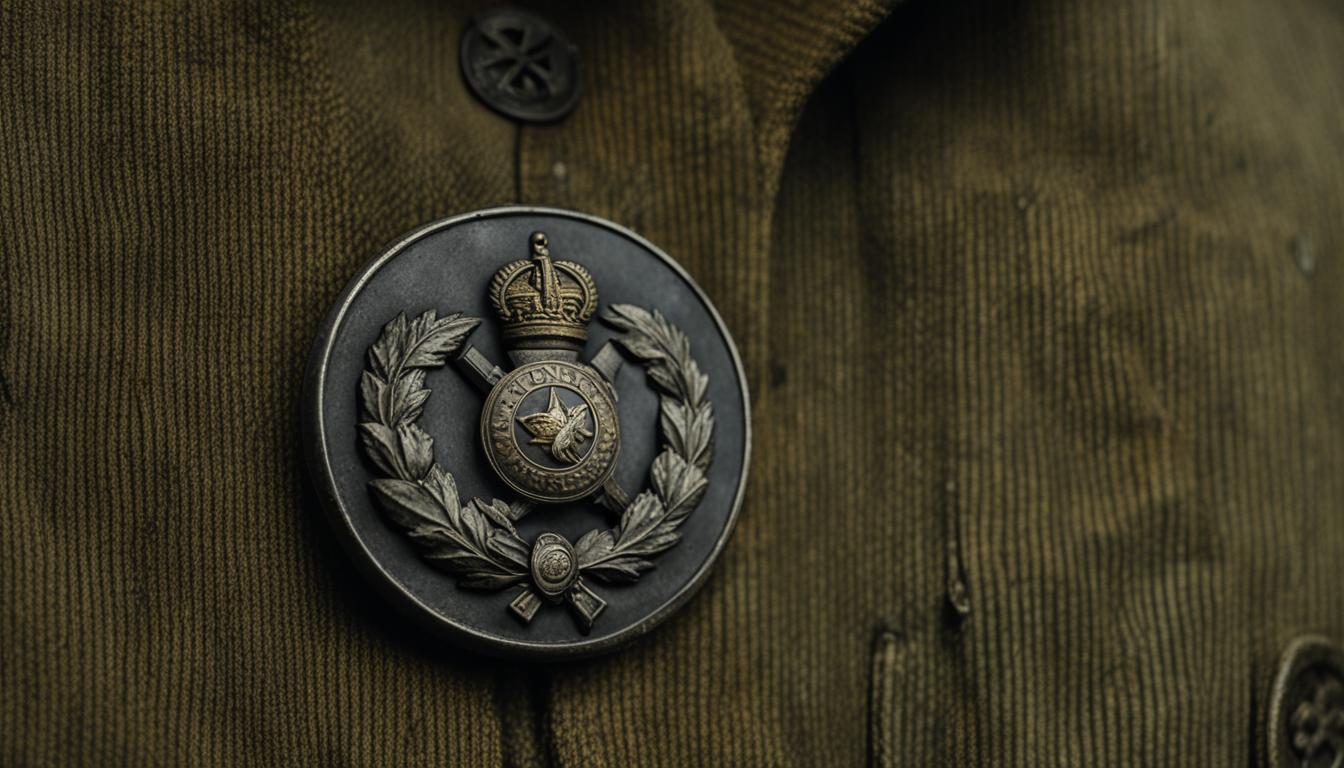When World War 1 erupted in 1914, it brought about significant changes in military uniforms. In the United States, the war effort led to the development of distinct WW1 uniforms that underwent remarkable transformations throughout the conflict. These uniforms reflected the evolving nature of warfare at the time.
Key Takeaways:
- WW1 uniforms underwent significant changes during the war.
- The United States developed its own distinct WW1 uniforms.
- The uniforms reflected the evolving nature of warfare at the time.
- Military uniforms played a crucial role in the overall war effort.
- Exploring WW1 uniforms provides insights into the history and culture of the early 20th century.
The Role of President Woodrow Wilson in Committing the US to War
President Woodrow Wilson played a crucial role in the United States’ entry into World War 1. Initially, The United States was determined to remain neutral and avoid getting involved in the conflict that was devastating Europe. However, President Wilson faced mounting pressure and had to carefully consider the nation’s position. After much deliberation, President Wilson made the difficult decision to ask Congress for a declaration of war against Germany on April 2, 1917.
The decision was not taken lightly and was met with great emotional turmoil. President Wilson believed that American intervention was necessary to make the world safe for democracy. He saw the war as an opportunity to bring about lasting peace and ensure that the values of freedom and justice prevailed. By committing the US to war, President Wilson set the stage for the development of World War 1 uniforms for American soldiers.
The Impact of President Wilson’s Decision
“I am not using the expression ‘serving our allies’… because we are not their allies. Our object is to serve nothing but the peace of the world, and in that service to serve nothing but the highest ideals of America… We shall never turn back or look the other way when tyranny and injustice threaten the peace of the world and the freedom of peoples.” – President Woodrow Wilson
President Wilson’s decision to commit the US to war had far-reaching consequences. It marked a significant turning point in the nation’s history and set the stage for American soldiers to enter the conflict. The impact of this decision reverberated through society, politics, and military affairs, including the design and production of World War 1 uniforms.
The move towards war necessitated the development of uniforms that would protect and equip American soldiers for the challenges ahead. With the entry of the US into the war, the demand for uniforms increased dramatically, requiring efficient production and distribution systems. President Wilson’s decision not only shaped the course of the war but also influenced the design and functionality of the uniforms worn by American soldiers.
| Impact of President Wilson’s Decision | Details |
|---|---|
| Increased demand for uniforms | The US entry into the war led to a surge in the production of uniforms to outfit the growing number of American soldiers. |
| Uniform design considerations | The need for functionality and practicality became paramount in the design of World War 1 uniforms, reflecting the nature of modern warfare. |
| Standardization of uniforms | President Wilson’s decision prompted the establishment of standardized uniform regulations to ensure consistency and efficiency in production. |
President Woodrow Wilson’s role in committing the US to war cannot be underestimated. His decision to ask Congress for a declaration of war against Germany set in motion a series of events that shaped the course of history. Without his leadership and conviction, the development and design of World War 1 uniforms may have looked very different. President Wilson’s vision for a safer, more democratic world influenced not only the military but also the lives of countless soldiers who donned these uniforms and fought for their country.
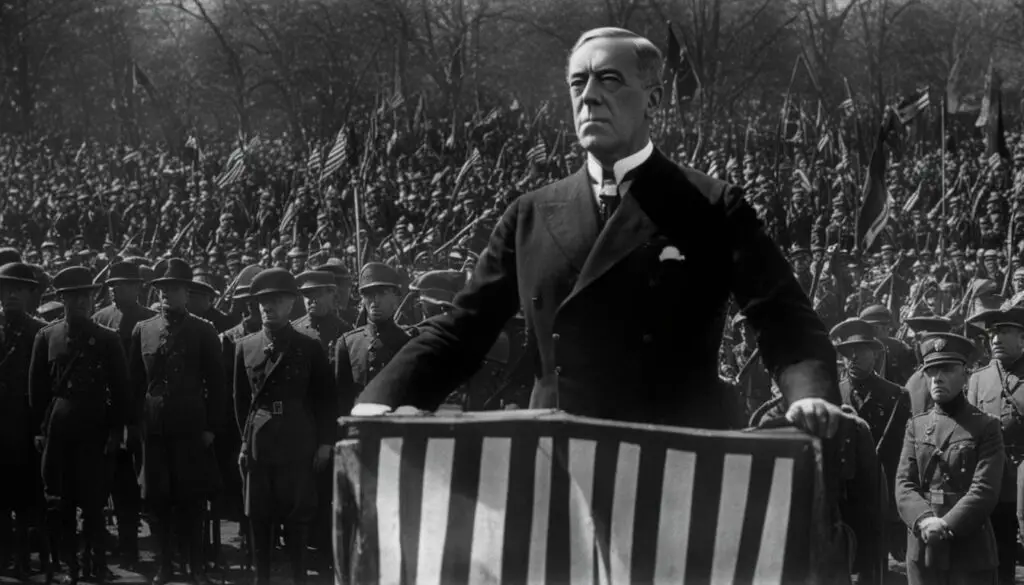
The Campaign to Mobilize Support for the War Effort
To ensure that Americans fully supported the war effort during World War 1, President Woodrow Wilson established the Committee on Public Information, led by George Creel. This committee spearheaded a massive propaganda campaign using various media platforms to rally public support for the war. The campaign aimed to convince citizens to contribute in any way they could, including through purchasing war bonds.
The Committee on Public Information utilized posters, pamphlets, and other forms of media to instill a sense of patriotism and duty in the American population. These propaganda materials depicted heroic soldiers, emphasized the importance of supporting the war, and appealed to people’s sense of national pride. Through carefully crafted messages, the campaign aimed to shape public opinion and garner widespread support for the war effort.
“The world must be made safe for democracy. Its peace must be planted upon the tested foundations of political liberty. We have no selfish ends to serve. We desire no conquest, no dominion. We seek no indemnities for ourselves, no material compensation for the sacrifices we shall freely make.” – President Woodrow Wilson
The Committee on Public Information understood the power of visual imagery and slogans to sway public sentiment. They employed influential artists, writers, and advertisers to create compelling and emotionally charged propaganda. The campaign’s success can be measured by the significant increase in war bond sales and the overall support demonstrated by the American people during World War 1.
| Propaganda Techniques | Examples |
|---|---|
| Appeal to Patriotism | Posters showing American flags and patriotic symbols |
| Fear and Guilt Induction | Posters depicting the consequences of enemy victory |
| Bandwagon Effect | Posters highlighting others’ contributions to the war effort |
| Emotional Appeals | Pamphlets evoking empathy for the suffering of soldiers |
The propaganda campaign during World War 1 not only rallied public support for the war effort but also played a significant role in shaping the attitudes and perceptions of the American population. By effectively utilizing propaganda techniques, the Committee on Public Information mobilized the entire nation and ensured that the United States was fully committed to the war against Germany.
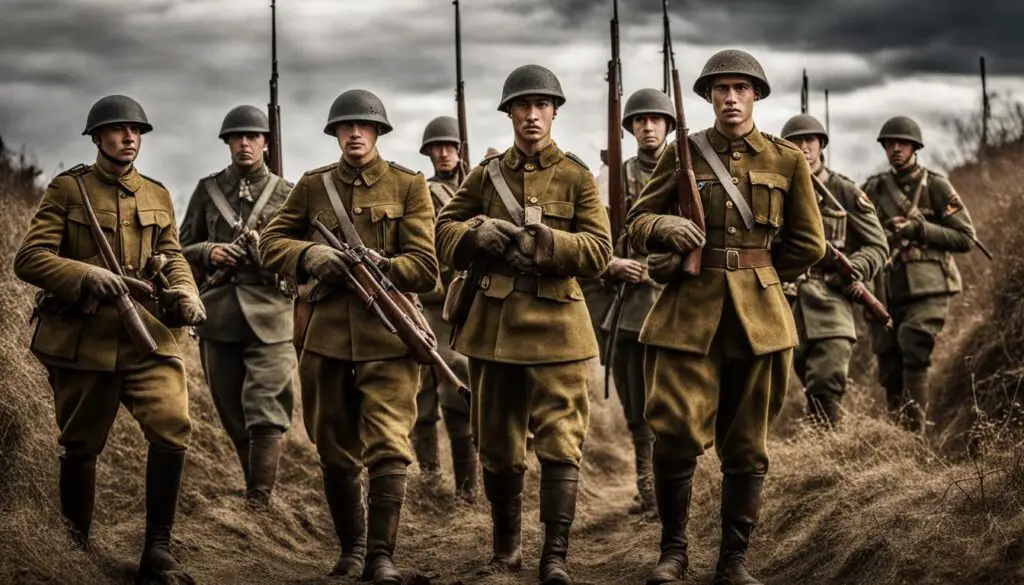
The Influence of Trench Warfare on Uniform Design
The brutal conditions of trench warfare during World War 1 necessitated the development of specialized uniforms. British military outfitters such as Aquascutum and Burberry played a significant role in creating these functional uniforms. The trench coat, originally designed for wet weather protection, was adapted for military use, offering soldiers protection from the elements and the flexibility needed for maneuvering in the trenches.
The trench coats created by Aquascutum and Burberry became iconic symbols of WW1 uniforms. Made from durable and water-resistant fabrics, these coats were designed to withstand the harsh conditions of trench warfare. They featured deep pockets for storing essentials, belted waists for adjustable fit, and epaulets for attaching rank insignia. The signature double-breasted front and wide collars provided extra warmth and protection.
“The trench coat was a true game-changer in terms of uniform design during World War 1,” says military historian [Researcher Name]. “Its functionality and adaptability became essential for soldiers in the trenches, offering much-needed protection while allowing ease of movement.”
In addition to the trench coat, other uniform elements were also influenced by the demands of trench warfare. Helmets were introduced to protect soldiers’ heads from shrapnel and debris. Gas masks became necessary to combat the threat of chemical warfare. And boots were designed with reinforced soles and ankle support to endure the muddy and treacherous conditions of the trenches.
The Role of Aquascutum and Burberry
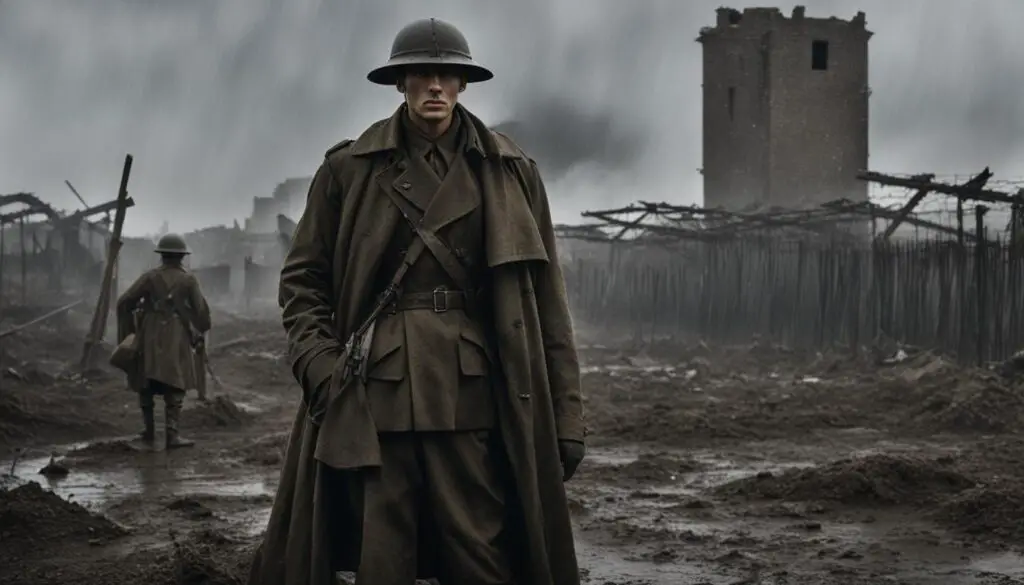
Aquascutum and Burberry, both British luxury brands, were chosen by the military for their expertise in creating high-quality, weather-resistant garments. Aquascutum, founded in 1851, specialized in waterproof fabrics, while Burberry, established in 1856, was known for its innovative use of gabardine, a durable and water-repellent material. These brands worked closely with the military to design and produce trench coats that met the specific needs of soldiers in the trenches.
The influence of trench warfare on uniform design during World War 1 cannot be overstated. The development of specialized uniforms, particularly the iconic trench coat, not only provided practical functionality but also shaped the image of soldiers on the battlefield. From their distinctive appearance to their ability to withstand the harsh conditions of war, WW1 uniforms became a symbol of resilience and adaptability.
| Key Features of WW1 Trench Coats | Aquascutum Trench Coat | Burberry Trench Coat |
|---|---|---|
| Waterproof | Yes | Yes |
| Deep Pockets | Yes | Yes |
| Belted Waist | Yes | Yes |
| Epaulets | Yes | Yes |
| Double-breasted Front | Yes | Yes |
| Wide Collars | Yes | Yes |
The Evolution of Military Tactics and Uniform Design
The advances in military technology and the changing nature of warfare in the early 20th century led to the adoption of khaki uniforms and the use of camouflage. The khaki uniforms blended with the landscape, making soldiers less visible to the enemy. This shift in uniform design reflected the need for soldiers to blend into their surroundings and adapt to the new realities of warfare.
The use of khaki uniforms in World War 1 marked a departure from the traditional brightly colored uniforms of the past. The vibrant colors made soldiers easy targets for enemy snipers and artillery. The introduction of khaki uniforms allowed soldiers to merge with the natural environment, increasing their chances of survival on the battlefield.
The concept of camouflage further enhanced the effectiveness of military uniforms. Soldiers were trained to use natural materials like foliage and mud to blend into their surroundings. This helped them to evade detection and launch surprise attacks on the enemy. Camouflage not only helped soldiers to stay hidden, but it also disrupted the enemy’s ability to accurately estimate the size and position of the opposing forces.
The Impact of Khaki Uniforms and Camouflage
The evolution of military tactics and uniform design during World War 1 had a profound impact on the outcome of battles. The adoption of khaki uniforms and the use of camouflage allowed soldiers to navigate the battlefield more effectively and gave them a tactical advantage over their adversaries.
“The introduction of khaki uniforms and the use of camouflage revolutionized warfare during World War 1. It changed the way soldiers fought on the battlefield and had a profound impact on military tactics.” – Military historian
| Advantages of Khaki Uniforms and Camouflage | Disadvantages of Brightly Colored Uniforms |
|---|---|
|
|
The evolution of military tactics and uniform design during World War 1 was driven by the need for soldiers to adapt to the changing realities of warfare. The adoption of khaki uniforms and the use of camouflage allowed soldiers to effectively blend into their surroundings, giving them a strategic advantage on the battlefield. This shift in uniform design reflected the growing awareness of the importance of concealment in modern warfare and set the stage for further advancements in military technology and tactics.
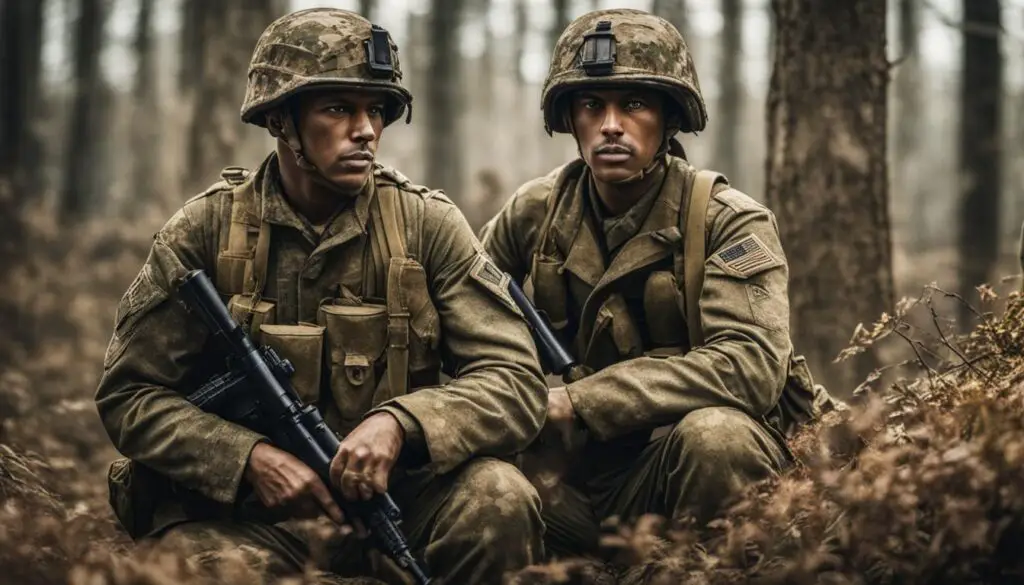
The Role of Officers in WW1 Uniform Design
When it comes to WW1 uniform design, officers played a distinct role in shaping their own attire. Unlike regular soldiers who were assigned standard uniforms, officers had the liberty to create their own unique style within certain parameters. They often turned to British military outfitters, such as Aquascutum and Burberry, to provide them with tailored and fashionable uniforms that reflected their rank and status.
These officer uniforms not only served a functional purpose but also reinforced the social hierarchy within the military. The high-quality materials and custom tailoring showcased the distinction between officers and enlisted soldiers. The officer uniforms became a symbol of authority and leadership, highlighting the importance of military rank and command structure.
The influence of officers on uniform design extended beyond aesthetics. Their feedback and demands for more functional features, such as additional pockets and reinforced stitching, contributed to the overall evolution of WW1 uniforms. The collaboration between officers and British military outfitters resulted in the development of uniforms that met the specific needs and preferences of those in command.
| Feature | Description |
|---|---|
| Tailoring | Officer uniforms were custom-tailored to ensure a perfect fit |
| Quality Materials | High-quality fabrics were used, reflecting the status of the officers |
| Decorative Details | Officers could embellish their uniforms with decorative elements, such as braiding and insignia |
| Functional Features | Officers often requested additional pockets and reinforced stitching for practicality in the field |
These officer uniforms not only showcased their individuality but also represented their authority and position within the military hierarchy. They provided a visual distinction between officers and enlisted soldiers, reinforcing the importance of rank and command. The influence of officers on WW1 uniform design left a lasting legacy and contributed to the overall evolution of military attire.
The Impact of WW1 Uniforms on War Technology
The development of WW1 uniforms had a wider impact beyond just the clothing itself. The functional design of the uniforms, with their adaptability and weatherproof features, set the stage for advancements in military technology. By prioritizing functionality and practicality in uniform design, military strategists and engineers were inspired to innovate in other areas of warfare as well.
One of the key technological advancements influenced by WW1 uniforms was the development of body armor. The need for increased protection for soldiers on the front lines led to the creation of lightweight but effective armor plates that could be integrated into a soldier’s uniform. This technology not only provided soldiers with better protection but also spurred further research into ballistic materials and designs.
Another area where WW1 uniforms had an impact was in the field of communication. With soldiers spread out across vast and treacherous terrains, the need for efficient communication was paramount. This led to the development of technologies such as wireless radios and signal equipment that could be easily carried by soldiers and integrated into their uniforms. These communication advancements revolutionized battlefield coordination and had long-lasting effects on military operations.
| Impact of WW1 Uniforms on War Technology | Technological Advancements |
|---|---|
| Body Armor | Development of lightweight and effective armor plates integrated into uniforms |
| Communication | Integration of wireless radios and signal equipment into uniforms |
| Improved Equipment | Enhanced design and development of weapons and tools |
Furthermore, the emphasis on functionality in WW1 uniforms also influenced the design and development of weapons and tools used by soldiers. The need for practicality and ease of use led to the creation of more efficient rifles, trenching tools, and other equipment. These advancements in military technology not only improved the effectiveness of soldiers on the battlefield but also laid the foundation for future developments in warfare.
In conclusion, WW1 uniforms had a far-reaching impact on the technology used in war. The functional design and adaptability of these uniforms inspired advancements in body armor, communication equipment, and overall military technology. By prioritizing practicality and functionality, military strategists and engineers were able to innovate and create tools that were more effective in the evolving landscape of warfare. The legacy of these innovations can still be seen in modern military technology today.
The Power of Propaganda in Shaping Public Opinion
During World War 1, propaganda played a vital role in shaping public opinion and rallying support for the war. The government launched a massive propaganda campaign, utilizing various forms of media to convey powerful messages and evoke emotions in the American population. Through war advertising, the government aimed to instill a sense of patriotism, fear, and guilt, influencing how people perceived the war and their role in it.
One of the key methods used in the propaganda campaign was the creation of posters. These visually striking images depicted heroic soldiers, devastated landscapes, and powerful slogans, all designed to evoke strong emotions and encourage individuals to support the war effort. The posters often featured catchy phrases such as “Enlist Today” and “Win the War with Liberty Bonds,” reinforcing the idea that citizen participation was essential for victory.
“We Can Do It!”
In addition to posters, other forms of media such as sheet music were also used to spread patriotic messages. Songs with titles like “Over There” and “Keep the Home-Fires Burning” became popular and served as a way to motivate and rally support. These songs and their lyrics tapped into the emotions of the time, invoking national pride and a sense of unity among the American people.
| Propaganda Medium | Description |
|---|---|
| Posters | Visually striking images with powerful slogans to evoke emotions and encourage support. |
| Sheet Music | Songs with patriotic lyrics that tapped into the emotions of the time and fostered a sense of unity. |
The power of propaganda during World War 1 cannot be underestimated. It successfully shaped public opinion, influencing individuals to support the war effort through various means such as enlisting in the military, purchasing war bonds, and contributing to the overall war effort. The impact of the propaganda campaign on public opinion and the war’s outcome cannot be ignored, making it a crucial aspect of World War 1 history.
The Significance of War Advertising and Propaganda
War advertising and propaganda not only rallied support for the war effort during World War 1 but also showcased the power of media and persuasive messaging. This period marked a turning point in the use of propaganda as a tool to shape public opinion, setting the stage for future propaganda campaigns in times of conflict and national crisis. Understanding the history and impact of propaganda during World War 1 provides valuable insights into the role of media in influencing public sentiment.
The Experiences of Soldiers in the Trenches
Life in the trenches during World War 1 was a harrowing experience for soldiers. They faced unimaginable challenges and hardships, both physical and emotional. Trench warfare, characterized by long stretches of stagnant fighting and constant danger, took a toll on the soldiers’ mental and physical well-being.
The soldiers spent days, weeks, and sometimes months in the cramped and unsanitary trenches. They endured extreme weather conditions, from freezing cold in the winter to sweltering heat in the summer. The trenches were infested with rats, lice, and other disease-carrying pests, creating unhygienic and unbearable living conditions.
Not only did the soldiers have to cope with the physical discomforts, but they also faced constant fear and the psychological stress of warfare. They witnessed the devastating effects of artillery bombardment, witnessed their comrades being injured or killed, and lived in constant anticipation of enemy attacks. The constant exposure to danger and the horrors of war left lasting emotional scars on the soldiers.
The experiences of soldiers in the trenches were a stark contrast to the image presented by the uniforms they wore. The uniforms were designed to be functional and provide some protection, but they often fell short in the harsh conditions of trench warfare. The heavy wool uniforms offered little protection from the cold and dampness, and soldiers struggled to keep their clothing dry and free from mud.
The soldiers carried their equipment and supplies with them at all times, adding to the weight and discomfort they had to endure. The cramped and confined spaces of the trenches made movement difficult, and soldiers had to navigate through narrow, muddy paths while carrying their rifles, ammunition, and other essential items.
The experiences of soldiers in the trenches highlight the immense challenges they faced and the sacrifices they made. Despite the shortcomings of their uniforms and the difficult conditions they endured, these brave individuals persevered in their duty and played a crucial role in the outcome of World War 1.
The Social and Cultural Impact of WW1 Uniforms
WW1 uniforms had a profound social and cultural impact that extended far beyond the battlefield. The functional and stylish designs of these uniforms influenced fashion trends and social norms in the post-war era. These uniforms were not only practical but also symbolized a crucial shift in societal attitudes towards the military and war.
The fashion influence of WW1 uniforms can still be seen today, particularly in military attire and outerwear. The iconic trench coat, originally designed for wet weather protection, became a staple in civilian fashion, reflecting the enduring influence of WW1 uniforms. Its functional design and versatility made it a timeless piece that continues to be embraced by fashion enthusiasts.
The post-war legacy of WW1 uniforms also contributed to social change. The war brought about a shift in gender roles, as women took on various roles traditionally reserved for men. This change was reflected in the evolution of women’s fashion, with many women adopting more practical and comfortable clothing, inspired by the functionality of military uniforms.
The Influence of WW1 Uniforms on Fashion and Style
WW1 uniforms had a significant impact on fashion and style, shaping trends and influencing the way people dressed. The sleek and tailored silhouettes of military uniforms inspired more structured and form-fitting clothing. The military-inspired look became a symbol of power and authority, attracting attention not only in the fashion industry but also in popular culture.
“The functional and stylish designs of WW1 uniforms influenced fashion trends and social norms in the post-war era.”
| WW1 Uniform Feature | Fashion Influence |
|---|---|
| Trench Coats | Became a timeless fashion staple |
| Military-Inspired Silhouettes | Influenced structured and form-fitting clothing |
| Functional Design | Embraced by both fashion enthusiasts and everyday individuals |
The Legacy of WW1 Uniforms in Society
The social impact of WW1 uniforms went beyond fashion, influencing societal attitudes towards the military and war. The uniforms represented the sacrifices made by soldiers and the collective effort required to overcome adversity. The sense of unity and camaraderie fostered by these uniforms contributed to a broader understanding of patriotism and national identity.
- The functional and adaptable designs emphasized the importance of practicality and efficiency in everyday life.
- WW1 uniforms symbolized the resilience and determination of those who fought in the war, leaving a lasting impression on society.
The social and cultural impact of WW1 uniforms continues to resonate today, reminding us of the power of fashion and the far-reaching influence of historical events. These uniforms serve as a tangible link to the past and a testament to the enduring legacy of those who served.
Conclusion
After delving deep into the fascinating world of World War 1 uniforms, it is clear that they played a significant role in shaping the history and culture of the early 20th century. From the decisions made by political leaders to the experiences of soldiers in the trenches, these uniforms carried immense historical significance.
The innovative designs of WW1 uniforms reflected the evolving nature of warfare during the time. The functional and practical features of these uniforms not only provided protection to soldiers but also paved the way for advancements in military technology. The development of trench coats and the adoption of khaki uniforms and camouflage were direct responses to the changing realities of warfare.
Furthermore, the propaganda campaigns during WW1 had a profound impact on shaping public opinion and rallying support for the war effort. The powerful advertising instilled a sense of patriotism, fear, and guilt in the American population, influencing how people perceived the war and their role in it.
It is important to recognize the social and cultural impact of WW1 uniforms as well. The functional and stylish designs of these uniforms influenced fashion trends and social norms in the post-war era. Even today, we can still see the legacy of WW1 uniforms in modern fashion and military attire.
In conclusion, the historical significance of World War 1 uniforms cannot be understated. They were not just clothing worn by soldiers, but symbols of a changing world and the role of the military in society. By understanding the stories behind these uniforms, we gain a deeper understanding of the sacrifices made and the impact they had on the course of history.
FAQ
How did the outbreak of World War 1 impact military uniforms?
The outbreak of World War 1 in 1914 led to major changes in military uniforms, including the development of distinct WW1 uniforms for the United States.
Why did President Woodrow Wilson ask Congress for a declaration of war?
President Wilson believed American intervention was necessary to make the world safe for democracy, leading him to ask Congress for a declaration of war against Germany in 1917.
How did the Committee on Public Information contribute to the war effort?
The Committee on Public Information, led by George Creel, spearheaded a massive propaganda campaign to rally public support for the war through various forms of media.
What role did trench coats play in WW1 uniforms?
Trench coats, originally designed for wet weather protection, were adapted for military use in the brutal conditions of trench warfare, offering soldiers protection and flexibility.
How did military tactics influence the design of WW1 uniforms?
The changing nature of warfare and advancements in military technology led to the adoption of khaki uniforms and the use of camouflage to make soldiers less visible to the enemy.
What distinguished officer uniforms from those of regular soldiers?
Officers had the freedom to create their own style within certain parameters and often turned to British military outfitters for tailored and fashionable uniforms, reinforcing the social hierarchy within the military.
How did the development of WW1 uniforms impact military technology?
The functional design of the uniforms paved the way for advancements in military technology, as the focus on functionality and practicality drove innovation in other areas of warfare.
What was the role of propaganda in shaping public opinion during WW1?
A massive propaganda campaign aimed to instill a sense of patriotism, fear, and guilt in the American population, influencing how people perceived the war and their role in it.
What were the challenges faced by soldiers in the trenches?
Soldiers in the trenches faced constant danger, harsh conditions, and the emotional toll of war while wearing uniforms that were not always comfortable or well-suited for their circumstances.
How did WW1 uniforms influence social and cultural norms?
The functional and stylish designs of WW1 uniforms influenced fashion trends and social norms in the post-war era, leaving a lasting legacy in modern fashion and military attire.
Source Links
- https://www.smithsonianmag.com/history/trench-coat-made-its-mark-world-war-i-180955397/
- https://historyexplorer.si.edu/sites/default/files/World_War_I_Lessons_and_Legacies_Educators_Guide.pdf
- https://www.pbs.org/wgbh/americanexperience/films/great-war/
